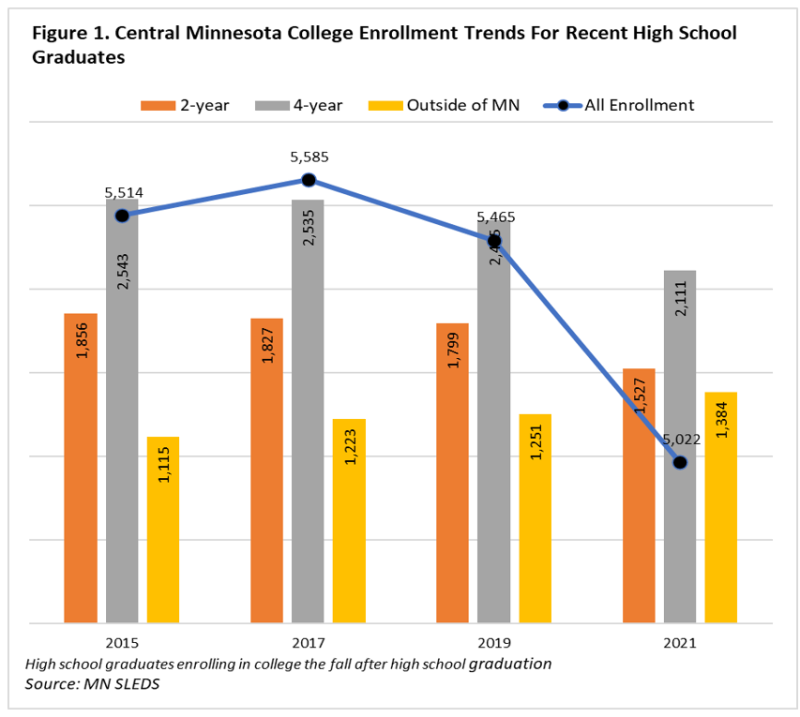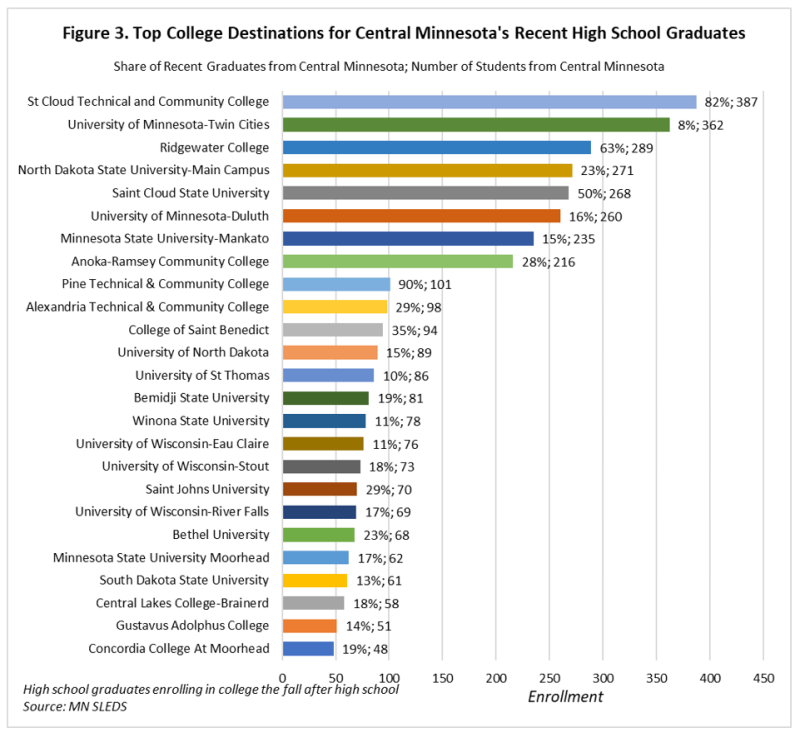by Luke Greiner
May 2023
Roughly 8,500 students graduate from Central Minnesota high schools each year, easily the largest and most important source of new labor we have. Students have an excellent array of options after graduating high school including pursuing higher education, becoming an apprentice, serving in the Armed Forces, or entering the labor market directly. Each path to success is as unique as the individual embarking on the journey. There is no single best option, and each path can lead to excellent careers with terrific earning potential.
Helping students explore the world of work and determine what they might enjoy and be good at has become a pillar of economic and workforce development efforts around the country, including in Central Minnesota. Yet there are many variable factors at play that are constantly changing such as student preferences, education initiatives, and economic conditions (not to mention a pandemic!) that shape the environment students navigate.
Looking at high school graduates who enrolled in higher education over the past half decade illustrates how shifting environmental factors influence what high school graduates do and where they go (Figure 1).

In the years prior to the pandemic, roughly 65% of high school graduates in Central Minnesota enrolled in college in the fall following graduation. Of students who immediately attended college, about 33% enrolled at a 2-year and 45% enrolled at a 4-year institution in Minnesota, while the remainder enrolled in college outside the state.
By 2021, immediate postsecondary enrollment of high school graduates dropped to 59%, meaning about 500 fewer Central Minnesota graduates enrolled in college in the fall after completing high school. The decline in enrollment was closely split between 2-year and 4-year institutions. However, colleges outside of Minnesota welcomed an increase of students from the region (see Figure 1).
While this decline might look troubling to some, much of the decline is related to the labor market. As surplus labor dried up, employers start to drop unnecessary educational requirements from their job postings in order to increase the pool of available applicants. And the decline does not mean there won’t be enough college-educated workers to meet economic demand, since only about 30% of all jobs in Central Minnesota require any formal education beyond a high school diploma to get started.
Scarce labor changes the demand of higher education by many employers for a large swath of occupations with the exception of requirements for licensure (thin RN or Civil Engineer). During the Great Recession when labor was plentiful employers used educational requirements as a filtering mechanism, asking for education levels not typically needed to perform occupations as a way to drill down to a manageable list of applicants. During this time of economic uncertainty and mass layoffs in the Construction and Manufacturing sectors, Minnesotans flocked to Higher Education, enrollments spiked and workers struggled to find openings and secure employment. Workers, parents, and students saw higher education as a necessity to set themselves apart from the competition, by 2009 there was an average of 12.3 unemployed workers for every job openings.
Booming higher education enrollment and surplus labor wasn’t destined to last long, up against an impending demographic from workers aging out of the labor force and the longest economic expansion in U.S. history (2009-2020). The sweeping demand for higher education drastically changed, by 2018 Central Minnesota had less than one unemployed worker available for each opening. Employers who just years earlier were struggling to wade through the excessive numbers of applicants suddenly didn’t have enough, and requirements for higher education was now working against them as a filter, essentially artificially limiting their pool of qualified applicants. Employers have been responding to the scarcity of labor by decreasing any barrier the might prevent applicants from applying or gaining employment, including educational requirements. By 2022 only 17% of job openings in Central Minnesota required a 2- year degree or more, down from 34% during the Great Recession (See Figure 2).

Despite educational requirements for job openings in decline, the cost for higher education continued to balloon, according to data from Minnesota's Office of Higher Education tuition and fees and Minnesota State public universities grew by over 49% from the start of the Great Recession until 2020, public 2- year school’s tuition and fees increased by 31%, both well above total inflation over this time at 27.5%.
The increasing cost coupled with a decreasing need for traditional higher education degrees in many occupations continues to be an important conversation for our employers, students and college system (See Figure 2). This underscores the importance of exploring careers early on and gaining some understanding of what education is typically required for occupations of interest.
For Central Minnesota students who continue their educational pursuits, many stay in the region. The largest number of high school graduates enrolling in the fall after graduating enrolled at St. Cloud Technical & Community College (387 enrolled), amounting to 82% of all recent high school graduates enrolled at their institution. Ridgewater College in Willmar and Hutchinson also are a huge draw for students in the region. At that rate, it’s easy to understand how important recent high school graduates from Central Minnesota are to many colleges in Minnesota.
Although the University of Minnesota was the second most popular destination for Central Minnesota high school graduates, they only comprised 8% of all recent high school graduates attending the university. Meanwhile 90% of enrollment by recent high school graduates at Pine Technical & Community College were from Central Minnesota, an incredibly important source of enrollment. Despite being a somewhat distant destination for college, North Dakota State University attracted 271 recent high school graduates from Central Minnesota, a higher number than St. Cloud State University, the largest college that is also located in the geographic center of the region (see Figure 3).

Most Central Minnesota high school graduates who enroll in college do so in the immediate fall following graduation, accounting for more than 60% of enrollment for students graduating between 2016-2021. Typically, another 7% of graduates will enroll in college within the next two years. With so many students enrolling in college in the fall immediately following high school graduation, it can be challenging to acquire enough experience and knowledge to make informed decisions.
With the cost of college in Minnesota growing roughly twice as fast as inflation since 2010, except for 2-year state colleges which exceeded inflation by 0.3 percentage points, the importance of making sound investments in higher education is more important every year.
Thankfully, a smaller share (7%) of students from Central Minnesota who do enroll in college need developmental education their first year compared to college-bound high school graduates statewide (9%). Developmental education, sometimes known as “remedial education,” is intended to help students succeed who do not score high enough on certain placement exams by reteaching high school-level content. Unfortunately, the need for developmental education indicates those students are not prepared for the rigors of college-level courses.
While developmental education courses are designed to prepare students for college-level courses, nationally only 28% of students who take a development course go on to earn a degree within 8 years. Developmental courses also increase the time to complete college while students pay for the course but do not receive college credit. (Source: https://files.eric.ed.gov/fulltext/ED565668.pdf)
Understanding what students do after graduating high school should help inform regional workforce and economic development strategies that prepare students. This can and should include connecting with mentors and work-based experiences to help students gain a better understanding of what educational pursuit, if any, best helps them achieve their desired career goals.
DEED provides help for students to navigate their own path to career success, including regional handouts that lay out a step-by-step career exploration process. In addition, DEED’s Career Pathways tool connects occupational data with educational programming from the Minnesota Department of Education and the Minnesota State Career Wheel, displaying career fields, clusters, and pathways. The primary goal of this dashboard is to help students understand how their educational path matches employment opportunities, and to inform education curriculum, initiatives, and programming to labor market realities. The tool is designed to help start career exploration with students, parents, and counselors.